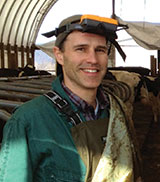
Pinching pennies may be old hat to some, but for others changing the way we think can uncover some untapped income opportunities.
Mike Hutjens presented “On-farm feed diagnostics” as the May webinar. The University of Illinois professor emeritus provided 10 on-farm tools and measurements to maximize on-farm feed value.
That list includes:
- Grain particle size
- Forage particle size
- Silage fermentation
- Feed efficiency
- Milk urea nitrogen
- Fecal washing
- Fecal scoring
- Fecal starch values
- Locomotion scoring
- Body condition scoring
These tools help identify nutrients that are passing through the cow without being utilized. For example, in the quest for increased production, does the ration mean cows are excreting extra protein in the manure? Protein is an expensive nutrient to feed but can also have negative environmental impacts if fed in excess. Monitor Milk Urea Nitrogen (MUN) levels to determine the farm’s level. Nine, 10, or 11 are ideal.
Adjusting rations can garner an additional 30 cents to 40 cents per cow per day by making the cow more efficient in how she digests and utilizes feed. Start by testing forages for fiber values because a big range exists. The Penn State Shaker box now contains a fourth box. The third box now has a screen that is 4 mm and the old diameter was 11 mm.
Take a closer look at concentrate particle size as its form evokes a different response in the cow. Hutjens also encouraged feeding rumen-protected methionine and rumen-protected lysine. The trend of higher kernal processing scores has been seen over the past six years, which is good, but there is still room for improvement. For the 2016 crop year, Dairyland Laboratories processed over 1,000 samples. Nearly 14 percent were less than ideal, which translates to corn that the cow should have used to make milk instead passed through to the manure.
If a cow is uncomfortable on her feet, she is not going to make as many trips to the feedbunk or stay as long, as compared to a completely healthy cow. There is lost production when cows are lame, even moderately, so Hutjens suggests locomotion scoring.
The body condition scoring chart has seen some adjustments recently as well. A tighter window of variation is encouraged. Dry cows are suggested to be at 3.00 to 3.25, while milking cows are preferred to be at 2.75 to 3.00. At 350 days postfreshening they should be back to that 3.00 to 3.25 level. It can be tough to get them to eat enough to maintain high production, but if they are loosing weight, reproduction will suffer.
Here are Hutjens’ guidelines and checklists. He explained the rationale behind these figures in the webinar, so we encourage you to sit down for an hour and review his presentation and maybe you can grab those dollars left on the table.

The webinar was sponsored by Ajinomoto Heartland.

The author is the online media manager and is responsible for the website, webinars, and social media. A graduate of Modesto Junior College and Fresno State, she was raised on a California dairy and frequently blogs on youth programs and consumer issues.
Next webinar:

The transition cow faces a number of challenges including metabolic and infectious diseases, which can cause problems throughout the upcoming lactation. This webinar will discuss energy balance and minimizing disease risk during this critical stage.
Register at www.hoards.com/webinars.








